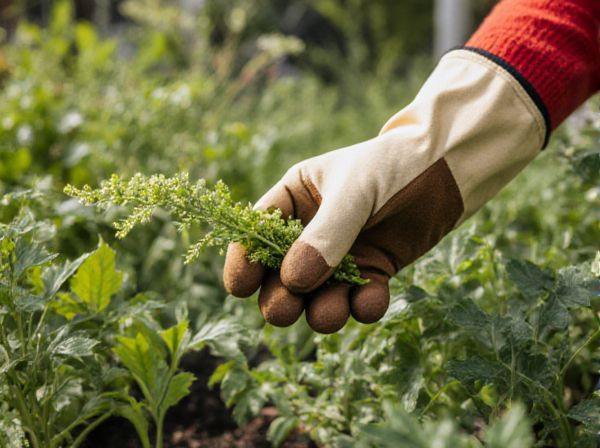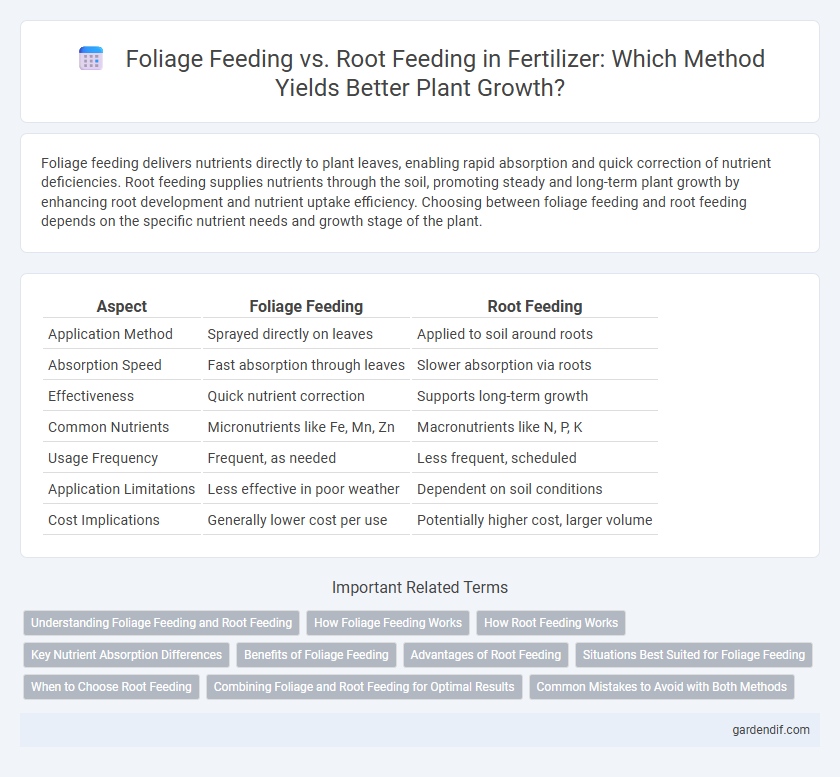
Foliage feeding vs root feeding Illustration
Foliage feeding delivers nutrients directly to plant leaves, enabling rapid absorption and quick correction of nutrient deficiencies. Root feeding supplies nutrients through the soil, promoting steady and long-term plant growth by enhancing root development and nutrient uptake efficiency. Choosing between foliage feeding and root feeding depends on the specific nutrient needs and growth stage of the plant.
Table of Comparison
| Aspect | Foliage Feeding | Root Feeding |
|---|---|---|
| Application Method | Sprayed directly on leaves | Applied to soil around roots |
| Absorption Speed | Fast absorption through leaves | Slower absorption via roots |
| Effectiveness | Quick nutrient correction | Supports long-term growth |
| Common Nutrients | Micronutrients like Fe, Mn, Zn | Macronutrients like N, P, K |
| Usage Frequency | Frequent, as needed | Less frequent, scheduled |
| Application Limitations | Less effective in poor weather | Dependent on soil conditions |
| Cost Implications | Generally lower cost per use | Potentially higher cost, larger volume |
Understanding Foliage Feeding and Root Feeding
Foliage feeding involves applying nutrient-rich solutions directly to plant leaves, enabling rapid absorption of essential elements like nitrogen, potassium, and micronutrients for immediate correction of deficiencies. Root feeding delivers nutrients to the soil, promoting sustained uptake through roots and supporting long-term plant growth by enhancing soil fertility and microbial activity. Understanding the balance between foliage feeding and root feeding optimizes nutrient availability, improving plant health and crop yield.
How Foliage Feeding Works
Foliage feeding delivers nutrients directly through the leaves by spraying liquid fertilizer, allowing rapid absorption of essential elements like nitrogen, potassium, and micronutrients. This method bypasses soil limitations such as poor nutrient availability or root damage, enabling immediate nutrient uptake and quicker correction of deficiencies. Effective foliage feeding enhances photosynthesis and overall plant health, especially during critical growth stages or environmental stress.
How Root Feeding Works
Root feeding delivers nutrients directly to the plant's root zone, allowing immediate absorption through root hairs and increasing nutrient uptake efficiency. This method enhances soil microbial activity, improving nutrient availability and promoting stronger root development. Consistent root feeding maintains essential macro- and micronutrient balance, supporting overall plant health and growth.
Key Nutrient Absorption Differences
Foliage feeding delivers nutrients directly to plant leaves, enabling rapid absorption of micronutrients like zinc, iron, and manganese, which are crucial for chlorophyll synthesis and enzyme function. Root feeding primarily supports macronutrient uptake such as nitrogen, phosphorus, and potassium, essential for overall plant growth, root development, and energy transfer processes. Leaf absorption bypasses soil-related nutrient immobilization, while root uptake relies on soil properties and microbial activity to convert nutrients into bioavailable forms.
Benefits of Foliage Feeding
Foliage feeding delivers nutrients directly to plant leaves, enabling rapid absorption and quicker correction of nutrient deficiencies compared to root feeding. This method enhances photosynthesis efficiency, supports faster growth, and improves resistance to environmental stressors by providing targeted micronutrients like zinc, manganese, and iron. Foliar application is particularly beneficial during critical growth stages or in soils where root uptake is limited due to pH imbalances or compaction.
Advantages of Root Feeding
Root feeding delivers nutrients directly to the plant's root zone, ensuring efficient absorption and minimizing nutrient loss through leaching or volatilization. It supports sustained nutrient availability, promoting stronger root development and improved overall plant health. This method enhances fertilizer use efficiency, leading to higher crop yields compared to foliage feeding.
Situations Best Suited for Foliage Feeding
Foliage feeding is best suited for situations where rapid nutrient absorption is needed, such as during nutrient deficiencies or stress conditions affecting root uptake. It is highly effective for trace elements like iron, manganese, and zinc, which plants readily absorb through their leaves. This method is ideal in greenhouse environments, hydroponics, or when immediate correction of nutrient imbalances is critical.
When to Choose Root Feeding
Root feeding is ideal during early growth stages when plants actively absorb nutrients through their roots to support strong root development and overall vigor. It is particularly effective for addressing nutrient deficiencies in the soil, ensuring long-lasting nutrient availability directly to the root zone. Choosing root feeding during transplanting or drought stress helps plants maintain health by providing essential minerals efficiently.
Combining Foliage and Root Feeding for Optimal Results
Combining foliage feeding and root feeding enhances nutrient absorption by delivering essential elements directly to the leaves while simultaneously enriching the soil for sustained root uptake. Foliage feeding provides rapid nutrient availability, particularly for micronutrients like iron and zinc, whereas root feeding supports long-term plant health through macronutrient supply such as nitrogen, phosphorus, and potassium. Integrating both methods optimizes plant growth, increases crop yield, and improves stress resistance by ensuring comprehensive nutrient coverage.
Common Mistakes to Avoid with Both Methods
Applying excessive fertilizer during foliage feeding can cause leaf burn and reduce plant health, while inconsistent root feeding may lead to nutrient imbalances and poor growth. Overlooking proper dilution rates and timing in both methods often results in inefficient nutrient uptake and wasted resources. Avoiding these mistakes ensures optimal fertilizer absorption and promotes vigorous, healthy plant development.
Foliage feeding vs root feeding Infographic

 gardendif.com
gardendif.com